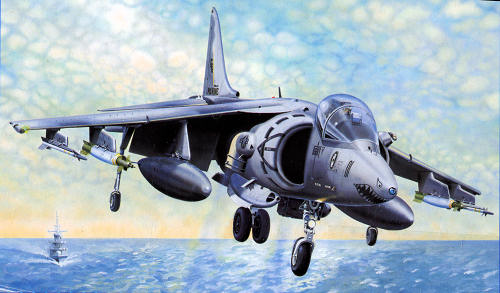
| KIT #: | 02229 |
| PRICE: | $170.00 SRP |
| DECALS: | Two Options |
| REVIEWER: | Scott Van Aken |
| NOTES: | New Mold kit |

| HISTORY |
The McDonnell Douglas (now Boeing) AV-8B Harrier II is a family of second-generation vertical/short takeoff and landing or V/STOL ground-attack aircraft of the late 20th century. It is primarily used for light attack or multi-role tasks, typically operated from small aircraft carriers and large amphibious assault ships.
Although the AV-8B Harrier II shares the designation with the earlier AV-8A/C Harrier, the AV-8B was extensively redesigned from the previous-generation Harrier GR.1A/AV-8A/C by McDonnell Douglas. British Aerospace joined the improved Harrier project in the early 1980s, and it has been managed by Boeing/BAE Systems since the 1990s.
The AV-8B is used by the United States Marine Corps. The British Harrier GR7/GR9 versions are used by the Royal Air Force and Royal Navy. Versions are also used by NATO countries: Spain, and Italy. The Harrier models are commonly referred to as the "Harrier Jump Jet". The type is scheduled to be replaced by the F-35C.
| THE KIT |
 Gotta say one thing for Trumpeter, they certainly have no problem releasing very large scale aircraft kits. Of course, one has to wonder how many of these things will be sold and how many have to be built to show a profit. Apparently they are thinking long term.
Gotta say one thing for Trumpeter, they certainly have no problem releasing very large scale aircraft kits. Of course, one has to wonder how many of these things will be sold and how many have to be built to show a profit. Apparently they are thinking long term.
Overall, the molding of the kit is everything we have come to expect from trumpeter in terms of recessed panel lines, crisp edges and the usual indented rivets in parts of the kit. This is designed to provide the basis for several different variants and there are quite a few when it comes to the Harrier II. I did notice some rather prominent seam lines on the wing tip upper and lower sections that you'll have to remove. Apparently there is a difference in wing tips between versions.
The cockpit is well done, though I'm sure that a resin seat will further enhance things. This kit has photo etch belts that will add to the overall look. There is a complete engine provided, though few will see it once it is installed. This might be an area for short cuts. You will need the housing, however, so that you can fit on the nozzles. As you might expect, the nose section is separate from the rest of the airframe, as it is with every Harrier kit I've seen. The intakes all have separate intake doors. These are rather loosely done on the real plane so those on the upper surface show 'open' and the lower ones are 'closed' with the engine not running.
Like many of Trumpeter's big kits, the flight control surfaces are separate, though designed to be affixed in the static position. One has a choice of gun pods or the replacement strakes. The list of 'things under wings' is long and includes Mk-117 bombs, Maverick missiles, fuel tanks, Mk 82 slick and snake-eye bombs, GUB-12 LGBs, and AIM-9L Sidewinders. The instructions have a full load-out sheet and the appropriate MERs/TERs if needed. The photo etch sheet contains an inner speedbrake detail piece as well as a HUD frame and mirrors. The kit has vinyl tires.
Typical also of Trumpeter, the color info for the build part of the instruction book is Gunze, while the color painting and marking guide offer other alternatives. There is a separate painting and marking sheet for weapons and pylons.
These are first generation Harrier IIs and the markings provided are for when the Harrier II when grey in the early 1990s. One is a Desert Storm plane from VMA-231 in a locally developed disruptive scheme. While there are color references for this and the other plane, I'd do some research before jumping in with Trumpeter's recommendations as they have proven to be less than accurate in the past. The other aircraft is more like the current scheme with VMA-542.

 I happen to have photos of both planes in my collection. Here is the VMA-542 plane (162962) in the scheme just before the introduction of the greys.
I happen to have photos of both planes in my collection. Here is the VMA-542 plane (162962) in the scheme just before the introduction of the greys.
 The other photo is VMA-231's aircraft (163662) in the exact camouflage scheme and markings as provided on the sheet. This was very much a field applied scheme so I wouldn't be to
The other photo is VMA-231's aircraft (163662) in the exact camouflage scheme and markings as provided on the sheet. This was very much a field applied scheme so I wouldn't be to  concerned about doing an ultra-tight camo pattern if you choose this one to model. If the paints chosen by Trumpeter are a match to the artwork above, they will be very wrong.
concerned about doing an ultra-tight camo pattern if you choose this one to model. If the paints chosen by Trumpeter are a match to the artwork above, they will be very wrong.
Kit decals are well done and should provide you with no troubles. As sheets go, it is pretty light on stencils, which is quite typical of the type.
| CONCLUSIONS |
There you have it. A nice large scale Harrier to add to your collection. It will be large, but then since the Harrier isn't exactly huge, it won't overwhelm your shelf.
| REFERENCES |
http://en.wikipedia.org/wiki/AV-8B_Harrier_II January 2010
Thanks to Stevens International via Tom Cleaver for the preview kit. If you would like your product reviewed fairly and fairly quickly, please contact the editor or see other details in the